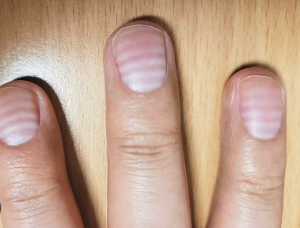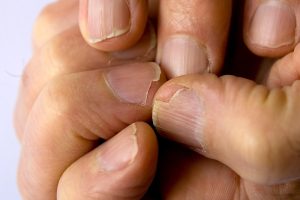Caring for your nails might seem like a purely cosmetic concern, but it’s much more than that. Nails not only add to our aesthetic appeal but also mirror our overall health.
Recognizing the signs your nails are showing can help in early detection of health issues.
Moreover, understanding how to care for them ensures they remain a healthy and attractive feature of your body. In this comprehensive guide, we’ll explore ten nail changes you shouldn’t ignore and provide expert tips on maintaining your nail health.
Nail changes to watch out for:

Horizontal white lines (Muehrcke’s lines)
These could indicate nutritional deficiencies like low levels of protein known as “albumin” in the blood or more severe conditions like kidney or liver diseases. It’s essential to monitor dietary intake and consult a healthcare provider if these lines appear.

Brown vertical stripes (Longitudinal melanonychia)
In a study conducted by Hiranmoy Samanta, a professor at the Gargi Memorial Institute of Technology, India, it’s pointed out that a dark stripe appearing at the nail’s cuticle (the layer of clear skin located along the bottom edge of your finger or toe) could be an early sign of melanoma, a serious type of skin cancer.
This research highlights the crucial need for early detection in effectively combating this form of cancer.

Ridges on nails
Beau’s lines or deep horizontal ridges can signal interruptions in nail growth due to illness or severe stress. Aging might cause vertical ridges. Regular moisturizing can help diminish these lines, but persistent Beau’s lines warrant medical attention.

Horizontal depression on the thumb
Known as habit tic deformity, this is often linked to stress or anxiety. Mindfulness and stress-reduction techniques can alleviate this habit, improving nail health.

Brittle nails
According to Healthline an American website and provider of health information, Brittle Nails is an indication of dietary deficiencies, exposure to harsh chemicals, or underlying health conditions like anemia or thyroid issues. Ensuring a balanced diet and protecting nails from chemicals can help.

Pitted nails
Often associated with psoriasis or alopecia areata, pitted nails may indicate an autoimmune condition according to the National Institute of Health (NIH). Regular check-ups with a dermatologist can help manage these conditions.
 Pale nails
Pale nails
According to Dr. Nmami Agarwal, a professional nutritionist from India and CEO of Nmami Life Pvt. Ltd, pale nails may suggest anemia or liver disease. Avoiding processed foods, including iron-rich foods in your diet and seeking medical advice for persistent paleness is advised.

Blue nails
Having blue nails is a sign of oxygen deprivation possibly due to respiratory or cardiovascular issues according to Dr. Nmami Agarwal. Consulting a healthcare provider is critical if nails persistently appear blue.

Yellow nails
Yellow nails could be linked to fungal infections, lung issues, or smoking. Maintaining good nail hygiene and consulting a doctor for treatment options is essential.

Clubbing of nails
This noticeable change in finger shape can be related to chronic low oxygen levels. Conditions associated with nail clubbing should be evaluated by a medical professional.
Caring for your nails
Balanced diet
Health professionals emphasize the importance of a diet rich in vitamins, minerals, and proteins for nail health. Foods high in biotin, such as eggs, nuts, and whole grains, can strengthen nails. Omega-3 fatty acids found in fish and flaxseeds promote moisture retention, combating brittleness.
 Moisturize regularly
Moisturize regularly
According to dermatologists, moisturizing nails and cuticles is crucial. Using a nourishing cuticle oil and hand cream can prevent dryness and cracking.
Grooming
Overzealous nail care can do more harm than good. Clipping nails after a shower when they’re softer and filing gently in one direction can prevent splitting. The Mayo Clinic advises against harshly pushing back cuticles, which can lead to infections.
Manicures
Opt for nail polishes free from harmful chemicals such as formaldehyde. The Environmental Working Group (EWG) offers a database to check the safety of cosmetic products. Acetone-free removers are less drying to the nails.
Protective measures
Wearing gloves while cleaning or gardening protects nails from damage and exposure to harsh substances. Limiting water exposure and avoiding nail-biting are also practices recommended by health blogs and dermatologists alike.
 Quit smoking
Quit smoking
The harmful effects of smoking on nails, staining them and impeding growth, are well-documented. Quitting smoking can significantly improve nail health, among other health benefits.
Regular check-ups
Routine visits to a dermatologist can help catch any early signs of nail or skin conditions. Professional advice can guide you in addressing any issues before they become severe.
In conclusion, your nails are windows to your internal health and deserve as much care as any other part of your body. Incorporating these nail care tips into your routine can not only enhance their appearance but also contribute to your overall well-being.
As always, if you notice any concerning changes in your nails, reaching out to a healthcare provider is the best course of action. Your nails are not just an accessory; they’re a vital part of your health story.


